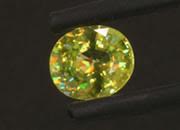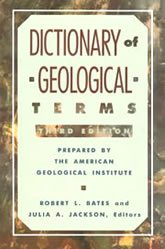Geological Terms Beginning With "S"
For terms beginning with other letters, please click below
|
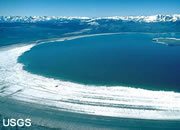
Saline Lake, Salt Lake
An inland lake in an arid area that is fed by local run off and has no discharge point. It loses water by evaporation and thus, dissolved solids carried into the lake do not escape the basin and become highly concentrated. Examples include Great Salt Lake and the Dead Sea. The photo shows Mono Lake of California. The white concentric rings around the lake are salt deposits left when water levels were higher.
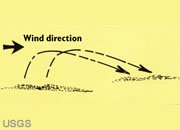
Saltation
The transport of sediment in short jumps and bounces above the stream bed or ground by a current that is not strong enough to hold the sediment in continuous suspension. (See suspension and traction for comparison.)
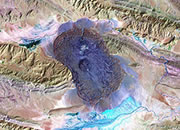
Salt Glacier
A mass of salt on land that deforms and flows down slope under its own weight - similar to the movement of an ice glacier. This movement is possible because of the plastic properties of salt - salt is able to deform and flow. Because salt is soluble, salt glaciers are only found in arid areas. The salt glacier in the image is located in the Zagros fold belt of Iran where a salt dome has broken through Earth's surface. The salt dome penetrated at the crest of a ridge and the salt is flowing down both flanks of the ridge.
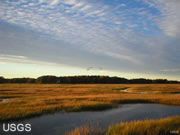
Salt Marsh
A marsh along a coastline that receives an inflow of ocean water during high tide and is populated by salt-tolerant vegetation. Also known as a "tidal marsh". The photo is of a marsh in the Plum Island Estuary that researchers believe will be submerged this century as sea levels rise.
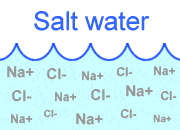
Salt Water or Saltwater ?
These words refer to water that is not fresh water. Salt water contains a high concentration of dissolved sodium chloride.
When written as 2 words, the word "salt" is an adjective used to describe the noun "water." For example, "The Earth's oceans and seas contain salt water."
When written as a single word, "saltwater" is an adjective used to describe a noun that follows it, as in "saltwater crocodile."
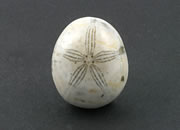
Sand Dollar
Sand dollars found on beaches today are remains of a group of animals that has lived in the oceans for millions of years. Their bodies are often agatized by nature and then found by people who polish them into gems.
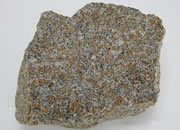
Sandstone
A sedimentary rock composed of sand-sized particles (1/16 to 2 millimeters in diameter).
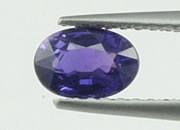
Sapphire
Sapphire is a gem variety of the mineral corundum. When it is reddish blue to violet-blue, it is known simply as "sapphire." Corundums of any other color (except red, which is ruby) are known as "fancy sapphires."
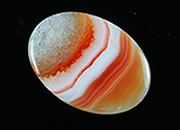
Sardonyx
Sardonyx is a member of the chalcedony family. It is a banded agate that contains bands of bright red alternating with agate of other colors.
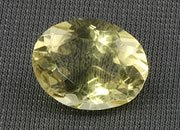
Scapolite
Scapolite is a metamorphic mineral that sometimes occurs in transparent gem-quality crystals that make beautiful faceted gems. Some specimens contain a silk that can produce a strong cat's eye.
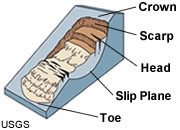
Scarp
An exposed face of soil above the head of a landslide. It is also an exposure of the slip plane or surface of rupture. Scarps are one of the first obvious and easy-to-recognize signs that a slide is in progress.
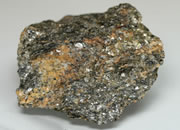
Schist
A metamorphic rock containing abundant particles of mica, characterized by strong foliation, and originating from a metamorphism in which directed pressure plays a significant role.
Schistosity
The parallel arrangement of platy or prismatic minerals in a rock that is caused by metamorphism in which directed pressure plays a significant role.
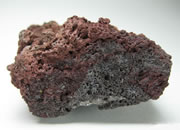
Scoria
An igneous rock of basaltic composition and containing numerous vesicles caused by trapped gases.
Sea-Floor Spreading
The process that occurs at mid-ocean ridges in which convection currents below pull the plates apart and create new sea floor.
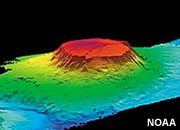
Seamount
A mountain on the sea floor that has at least 1000 meters of local relief. Most seamounts are shield volcanoes. Seamounts with a flat top produced by wave erosion are known as guyots. Shown in the image is the Bear Seamount of the North Atlantic Ocean about 200 miles east of Woods Hole, Massachusetts.
Sediment
A loose, unconsolidated deposit of weathering debris, chemical precipitates or biological debris that accumulates on Earth's surface.
Sedimentary Rock
A rock formed from the accumulation and consolidation of sediment, usually in layered deposits.
Sedimentary Structure
A structure in a sedimentary rock that forms at or near the time of deposition and reveals information about the depositional environment. Examples include: ripple marks, cross-bedding, mud cracks, and graded bedding.
Sedimentation
The process of sediment deposition from out of a suspension or solution.
Seepage
The slow movement of water through the pore spaces of a solid material. This term is also applied to a loss of water by infiltration through the bottom of a stream, canal, irrigation ditch, reservoir or other body of water.
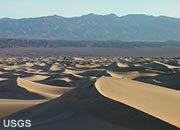
Seif Dune
A large sand dune that forms parallel to the direction of a strong wind that blows in a consistent direction throughout the year. Also called a longitudinal dune.
Seismic Discontinuity
A surface separating rocks that transmit seismic waves at different velocities.

Seismicity
The study of the worldwide distribution of earthquakes and crustal movement over time and the probability of an earthquake occurring in a specific location.
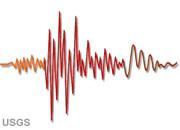
Seismic Wave
A generic term for the numerous types of waves that are produced by an earthquake and travel through the earth. Depending upon the intensity, depth and location of the earthquake these vibrations might or might not be felt at the surface by people.

Seismogram
A paper, film or digital recording of an earthquake's vibrations that is produced by a seismograph.
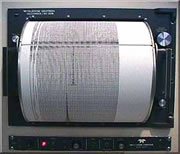
Seismograph
The study of the worldwide distribution of earthquakes over time and the probability of an earthquake occurring in a specific location.
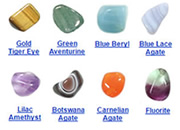
Semiprecious Stones
"Semiprecious stones" is a name used for all varieties of gemstones that are not categorized as "precious." Semiprecious stones are any gemstones other than diamond, ruby, sapphire, or emerald that are suitable for being used in personal adornment. These classifications of gemstones became popular in the 1800s, and most members of the gems and jewelry industry have used them. Today many people believe that the use of the term "semiprecious" is derogatory because any material worthy for use as a gemstone should be considered as "precious."
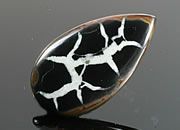
Septarian
"Septarian" is a name used for round concretions with internal mineral-filled fractures found in sedimentary rocks. They are often cut into cabochons that display the interesting geometry of the fracture network.
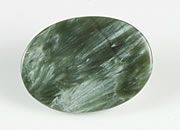
Seraphinite
Seraphinite is a trade name used for a gem material composed of the mineral clinochlore. It is usually greenish in color and marked with fibrous or feather-like patterns. Its hardness is only 3 to 4 and is reserved for delicate use.
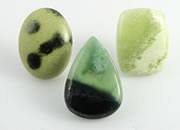
Serpentine
A silicate mineral, that occurs in a wide range of green and greenish colors with interesting patterns that is often cut into cabochons or used as an ornamental stone.
Service Well
A well drilled to support production from other wells. Some reasons for support wells are: gas injection, water injection, steam injection, salt water disposal, water supply, observation, or combustion air injection.
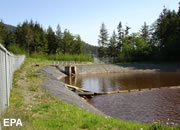
Settling Pond
An open pond where runoff, waste or process water is allowed to stand while suspended materials settle out. Settling ponds are common at surface mines, drilling sites, landfills, construction sites, industrial facilities and many other locations.
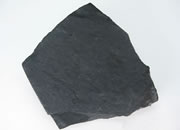
Shale
A clastic sedimentary rock that is made up of clay-size (less than 1/256 millimeter in diameter) weathering debris. It typically breaks into thin flat pieces.
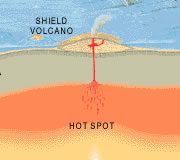
Shield Volcano
A broad volcano with a very gentle slope that has been built up by many successive flows of low viscosity lava, usually of basaltic composition. The Hawaiian Islands are the best-know example of shield volcanoes.
Short Ton
A unit of weight that equals 2,000 pounds.
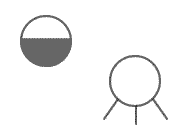
Shut In
An oil or gas well that is capable of production but which is temporarily closed. The most common reason for a well to be "shut-in" is a lack of pipeline capacity or lack of access to markets. In some cases a lessee might drill a well to fulfill a lease commitment and then shut the well in until pipeline capacity or a favorable sales contract is available. This is often a strategy to lock-in the lease without additional cost. Shut-in wells can also be closed for maintenance. The image shows the map symbols for shut in oil wells (left) and gas wells (right).
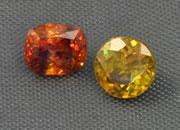
Siderite
Siderite is an iron carbonate mineral with a very high dispersion. Transparent crystals of siderite with great clarity can be cut into attractive gemstones with a strong fire. It is too soft for most jewelry and is a collector's stone.

Signing Bonus
Money paid to a mineral rights owner in exchange for granting a lease. This payment may be in addition to rental or royalty payments.
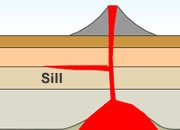
Sill
A subsurface igneous rock body that is tabular in shape and has intruded between layers of the sedimentary or metamorphic country rock. A sill might branch off of a dike, a volcanic pipe, or any other intrusive rock unit.
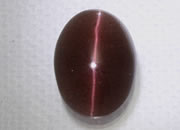
Sillimanite
Sillimanite is a metamorphic mineral that often has a fine fibrous silk. When properly cut, cabochons of the material can reflect a sharp cat's eye.
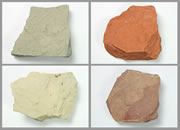
Siltstone
A clastic sedimentary rock that forms from silt-size (between 1/256 and 1/16 millimeter diameter) weathering debris.

Silver
Silver is a precious metal that is often present as visible crystals in its ore. Some people enjoy seeing the bright metal reflecting from the surface of a cabochon. It is a novelty gem.
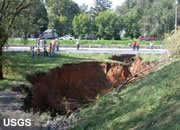
Sinkhole
A depression in the land surface that results from the collapse or slow settlement of underground voids produced by solution weathering. The rock being dissolved is normally limestone but can also be salt, gypsum or dolostone. The photo shows a sinkhole that formed near Frederick, Maryland.
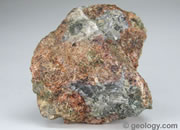
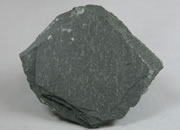
Slate
A foliated metamorphic rock that is formed through the metamorphism of shale. It is a low grade metamorphic rock that splits into thin pieces.

Slip Plane
The surface of failure below a landslide (often called the "surface of rupture"). The moving mass of the slide travels over the slip plane.
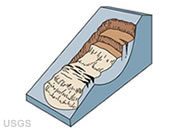
Slump
Also known as a "rotational slide". A slide in which the surface of rupture, or slip plane, is curved concave upward and the slide movement is roughly rotational instead of translational.
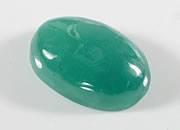
Smithsonite
Smithsonite is a zinc carbonate mineral that serves as a minor ore of zinc and as a minor gem mineral. It is relatively soft and used as a collector's gem and in jewelry that is unlikely to receive abrasion or impact.
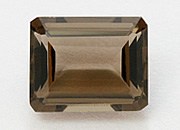
Smoky Quartz
Smoky quartz is a grayish brown to nearly black variety of transparent quartz. It is often cut as a faceted stone or cabochon. Upon heating, it will sometimes change in color to yellow or yellowish brown citrine.
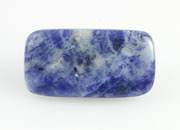
Sodalite
A feldspathoid mineral that ranges in color from white to blue to violet blue. It is often used to make cabochons, tumbled stones and other lapidary projects.
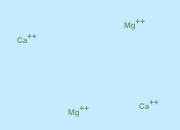
Soft Water
Water that does not contain significant amounts of dissolved calcium and magnesium ions that can interfere with the performance of many soaps and detergents. These dissolved substances are also not present to leave a scaly deposit in containers where it is heated or evaporates (although other dissolved substances might leave such deposits).
Solution
A chemical weathering process in which a material is dissolved. Also, the transport of dissolved ions by the water of a stream.
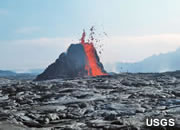
Spatter Cone
A small volcanic cone with a central vent and steep sides that ejects molten lava into the air. The lava is airborne for a short distance but falls to the ground before solidifying. Upon impact, the molten lava welds to previously ejected material - which is known as "spatter". Most spatter cones are less than 30 feet tall and are built of basaltic material.
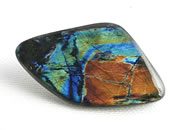
Spectrolite
Some specimens of gem-quality labradorite have exceptional color and labradorescence. These unusual gems are given the name "spectrolite" because of the spectrum of colors that they reflect.
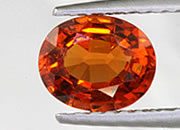
Spessartine Garnet
Spessartine is also known as "spessartite" or as "mandarin garnet" because of its yellow-orange to orange-red color. It is a popular variety of garnet used in jewelry.
Sphene
Sphene, also known as titanite, is a gem with a dispersion higher than diamond. Specimens of high clarity can be cut into gems with a brilliant fire. Its softness limits its use to earrings, pins, pendants, and low-abrasion jewelry pieces.
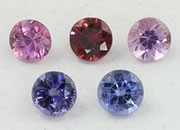
Spinel
A mineral of many colors that has been treasured as a gem for thousands of years. It was often confused with ruby and sapphire. Many of these errors were not discovered until the 20th century.

Spring
A geographic location where groundwater naturally discharges onto Earth's surface or into a body of surface water such as a swamp, river, lake, sea or ocean.
|
Dictionary of Geological Terms - Only $19.99 All scientific disciplines have an essential vocabulary that students and professionals must understand to learn and communicate effectively. A geology dictionary that is used regularly is one of the most important tools for developing professional competence. A good dictionary should be on the desk of every geologist and within easy reach. This dictionary is compact and inexpensive at only $19.99. More information. |
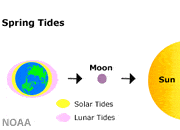
Spring Tide
A daily tidal range of maximum amplitude that occurs when the earth, moon and sun are in alignment with one another. In this moon-earth-sun configuration, the gravitational attraction of the moon and sun work together to pull Earth's water into two bulges on opposite sides of the Earth. Occurs at the second and fourth quarters of the moon. See neap tide for contrast.
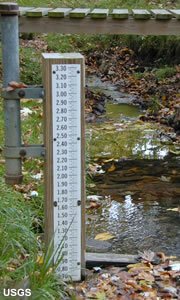
Stage
A measured height of water above an arbitrary reference datum. Frequently used to describe the height of water in a stream, lake, well, canal or other water body. Stage and gage height are equivalent words, with stage being more commonly used by the public. Gage height is usually measured at a gaging station.
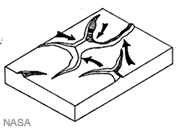
Star Dunes
Radial shaped sand dunes with three or more arms. They form in areas where there is no dominant wind direction and wind blows from many different directions. They tend to accumulate upwards instead of moving laterally. This enables them to become some of the tallest dunes in the world.

Stock
A relatively small igneous intrusion that forms when magma crystallizes underground. Although uplift and/or erosion can later unearth part of a stock, this feature is defined as having less than 40 square miles (100 square kilometers) exposed at the surface.
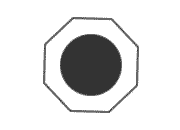
Storage Well
A well where natural gas, crude oil, helium or another fluid is injected into temporary underground storage. In some areas the winter demand for natural gas for space heating is enormous but the pipeline capacity into that area is limited. So, all summer, natural gas will flow in from the producing area, injected underground and then withdrawn during the winter heating system. The image is the map symbol for a natural gas storage well.
Storm Sewer
A sewer system that collects surface runoff instead of waste water. These two types of water are kept separate because they require different processing before release to the environment.
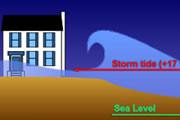
Storm Surge
The piling up of water along a shoreline cause by the sustained winds of a strong storm - usually a hurricane.
Strain
A change in the volume or shape of a rock mass in response to stress.

Strata
A generalized term used in reference to a group of rock layers. "Strata" when plural, "stratum" when singular. These layers can be distinguished from layers above them and below them by differences in mineral composition, grain size, color, fossil content, grain orientation or other characteristic. The image is from William Smith's 1815 Geological Map of England and Wales and Part of Scotland.
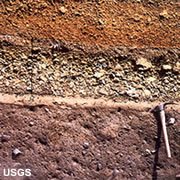
Stratification
A layered structure of sedimentary and other types of rocks in which the individual layers can be recognized and traced laterally because they differ in composition, color, grain size, fossil content, grain orientation or other observable characteristic.

Stratified
A material that has been deposited in layers. Many types of processes can produce stratified deposits. These include: clastic sedimentation, chemical sedimentation, biological sedimentation, ashfalls, lava flows, pyroclastic flows, landslides, asteroid impacts and others. Shown in the image is a sequence of stratified tuff accumulated near the Mount St. Helens eruption.
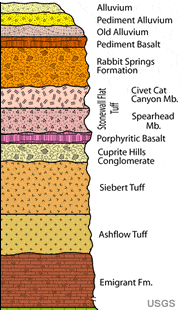
Stratigraphic Column
A diagram that shows the vertical sequence of rock units present beneath a given location with the oldest at the bottom and youngest at the top. They are typically drawn to approximate scale with proportional rock unit thicknesses. Colors and standardized symbols are usually added to graphically communicate rock types and some of their more important features. Geologic columns prepared for regions will have generalized thicknesses and rock unit features that show relationships that change over distance.
Stratigraphic Sequence
The sequence of sedimentary rock layers found in a specific geographic area, arranged in the order of their deposition.
Stratigraphy
The study of sedimentary rock units, including their geographic extent, age, classification, characteristics and formation.
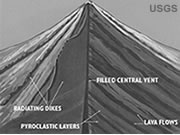
Stratovolcano
A volcanic cone made up of alternating layers of lava flows and pyroclastics. Also known as a composite cone. Most of the volcanoes in the Cascades Range are stratovolcanoes.
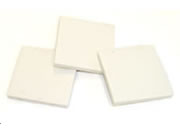
Streak
The color of a mineral in powdered form. Streak is normally determined by scraping a specimen across a surface of unglazed porcelain known as a "streak plate".

Streak Plate
A piece of unglazed porcelain that is used for determining the streak of a mineral specimen.
Stream Order
A classification system that represents the relative position of streams in a drainage basin. The highest tributaries in the basin are first order streams. These converge to form second order streams, which have only first order streams as their tributaries. Third order streams form by the confluence of two second order streams. The numbering system continues downstream resulting in higher stream orders.
Stress
A force acting upon or within a mass or rock, expressed in terms of unit weight per surface area such as tons per square inch.
Striations
Scratches or grooves on a rock or sediment surface caused by abrasive action of objects being transported above it by ice, water or wind.
Strike
The geographic direction of a line created by the intersection of a plane and the horizontal. Often used to describe the geographic "trend" of a fold or fault.
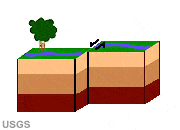
Strike-Slip Fault
A fault with horizontal displacement. Strike-slip faults are typically vertical or near vertical and are typically caused by shear stress. They are the typical fault of transform plate boundaries. The San Andreas Fault is the world's most famous example of a strike-slip fault.
Stromatolite
A mound-shaped fossil that forms from the repetitious layering of algal mat covered by trapped sediment particles.
Strombolian Eruption
A type of volcanic eruption characterized by fountains of lava jetting from a lava-filled central crater.
Subduction Zone
An area at a convergent plate boundary where an oceanic plate is being forced down into the mantle beneath another plate. These can be identified by a zone of progressively deeper earthquakes.
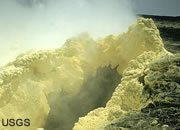
Sublimation
The process by which a solid is deposited directly from a gas without going through a liquid phase. Sublimation frequently occurs around volcanic vents where minerals such as sulfur, orpiment, realgar, and cinnabar are deposited. Even minerals like beryl can be deposited directly from hot gases in hydrothermal veins. These specimens are often of great purity because the crystals grew by the direct deposition of atoms.
Submarine Canyon
An underwater canyon, carved into the continental shelf. These can be carved by turbidity currents or carved subaerially during a time when sea level was lower.

Subsidence
A lowering of the land surface in response to subsurface weathering, collapse or slow settlement of underground mines, or the production of subsurface fluids such as groundwater or oil. The photo shows a sinkhole that formed near Frederick, Maryland.
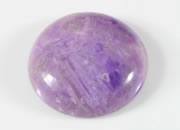
Sugilite
Sugilite is a rare silicate mineral only discovered in 1944. It occurs in yellow, brown, pink and purple and is often combined with quartz. The purple color has become very popular in the lapidary trade. Its high price limits its popularity.
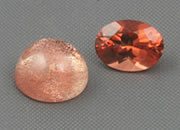
Sunstone
A plagioclase feldspar that can be a colorful transparent gem. It can also contain plate-shaped copper inclusions that produce an aventurescent flash when moved under incident light. These specimens are from Oregon.
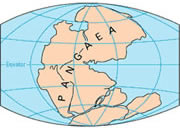
Supercontinent
A large landmass that forms from the convergence of multiple continents.
Superposed Stream
A stream that cuts across resistant bedrock units. This can occur when the stream's course was determined at a previous time and on a previous landscape.
Superposition
The concept that the oldest rock layers are at the bottom of a sequence with younger rock layers deposited on top of them. This can be considered a rule that applies in all situations, except where the rocks are extremely deformed.
Supersaturated Solution
A solution that contains more solute than its solubility allows. Such a solution is unstable and precipitation can be triggered by a variety of events.
Surf
The breaking of waves as they enter shallow water.
Surf Zone
An area of breaking waves bounded by the point of first breakers, then landward to the maximum uprush of waves on the beach.
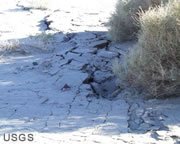
Surface Rupture
The location where the displacement of a fault cuts the Earth's surface. Because the surface is usually covered with soil or other loose material, the rupture may be an "area of disturbance" rather than a clean break.
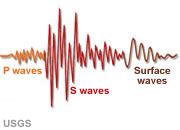
Surface Wave
A type of seismic wave that travels along Earth's surface. These are the waves that cause the most damage during an earthquake.
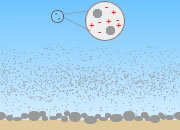
Suspended Load
Small particles being carried by a stream and held in suspension by the movement of the water. The blizzard of tiny particles in the image represent the suspended load of a stream. They contrast with the larger particles of bedload on the bottom of the stream and the dissolved load of ions represented as the "+" and "-" symbols in the enlargement. Many streams only have a suspended load during times of high flow. Most of the time the water in the stream is clear and moving at such a slow rate that particles are not held in suspension.
Suspension
Transport of sediment by wind or water currents that are strong enough to keep the sediment particles continuously above the stream bottom or ground.
Swash
The rush of a breaking wave up the slope of a beach.

S-wave
Secondary seismic waves. A seismic wave with a direction of vibration that is perpendicular to the direction of travel. S-waves are slower than P-waves and travel only through solids.
Symbiosis
A relationship between two species who live in close association but do not compete with each other or prey on one another. At least one of the species derives benefit from this association.
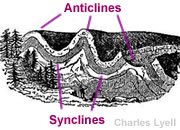
Syncline
A trough-shaped fold with youngest strata in the center. Sketch by Sir Charles Lyell.
System
A stratigraphic unit of major significance which was deposited during a specific time period, and which can be correlated worldwide on the basis of its fossil content.
|
| More General Geology |
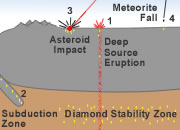 |
Diamonds from Coal? |
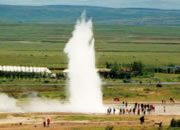 |
What is a Geyser? |
 |
What is the San Andreas Fault? |
 |
Igneous and Volcanic Features |
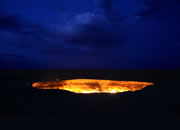 |
The Doorway to Hell |
 |
Topo Maps |
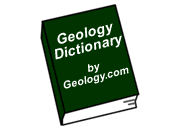 |
Geology Dictionary |
 |
Gifts That Rock |

Find Other Topics on Geology.com:

|

| ||

|

| ||

|

| ||

|

|

